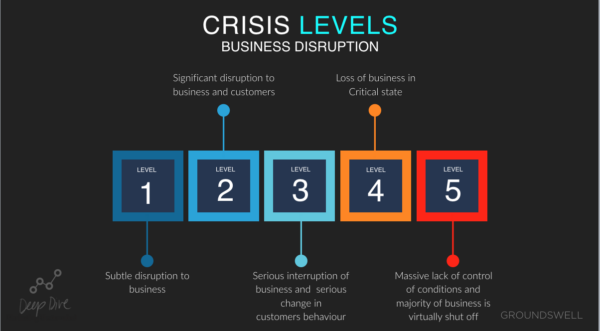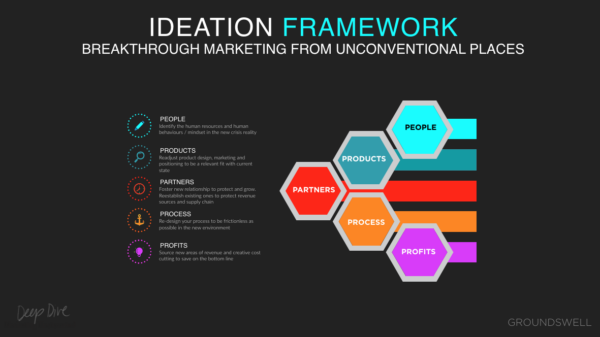COVID-19 is a punch in the gut crisis for most everyone and most certainly business owners. They are challenged with adapting in lightning speed with so many simultaneous challenges. When John F. Kennedy famously quoted “When written in Chinese, the word ‘crisis’ is composed of two characters, One represents danger and the other represents opportunity” he was drawing attention to the potential of a positive side of the problems we are faced with. In the words of Tony Robbins, “Problems are a gift and without them, we would not grow’. I am sure many people do not view the current challenges as a ‘gift’ yet. This might be one of the single biggest openings for a new innovation to change your business to be more resilient or for the better. This may require systematically and strategically digging into the existing resources within your business and team to find it. It also may be some time for businesses to feel like this crisis has a positive outcome for them, but it starts with mindset. This way of thinking is about ‘adaptive ideation’ – where you generate hypotheses and scenarios to anticipate how you can adjust your business decisions.

Crisis Levels by Groundswell
The adaptive ideation methodology was my triage approach of helping clients navigate change several weeks ago I had created 5 levels of crisis so the business owner could plan for upcoming changes. The world didn’t anticipate how severe or how fast these challenges would be, and how could we? It is so unbelievable we are at level 5 crisis where an unprecedented global phenomenon crisis is affecting every country. Defining and gauging the severity of the problem is the first step in the process of creatively solving it. If you find yourself in Level 4/5 its serious and you are looking for insights to help keep your business functioning.
When I first worked on developing a strategy of staged response to my business based on levels of severity, I could not have anticipated how fast things changed. However, because I initiated a plan in advance to have actions that I could strategically execute as things beyond my control happened, I felt at least I was not caught flat footed. In fact this process enabled me to shift my business and I am ahead of the curve helping my clients remotely and identified new solutions to help my own clients in difficult time. – Craig Bundren / CEO Bundren
Many business owners are asking themselves “What do I do now?” Amidst the massive economy shut down around the world there is no easy answers.
Shifting your business from surviving to a rapid strategy of thriving is completely possible. Over the past 2 weeks I have been coaching businesses over video conferencing about ideas on how to adapt during these difficult times.
Several patterns have emerged and I am seeing several repeatable things to help with organizing your thoughts, mindset and thinking so that you can be more creative and solve intelligently.
The first thing I would like to underscore is that every business is different with its cash flow, reserves, resources and so forth. This matters because you must take a holistic approach to identifying what you can do not just
look at loss of sales.
What I have established is 4 steps based on over multiple consulting efforts to guide business during this global Coronavirus Crisis.
Step1: Cash Flow Crunch: Immediate strategies to preserve cash, resources and adjust your business to the immediate changes.
Example questions: What is your current cash position? What is your burn rate? What accounts receivable can you secure?
Step2: Rapid Revenue Ideation: Using existing resources to shift to meet new demand and client realities.
Example questions: What do we currently offer that we can still deliver on? What changes could we make to still fulfil orders? What new adjustments can we make to what we offer that fits the current situation?
Step 3: Short Term Planning: How to diversify revenue and bring down costs
Example questions: Is there a new revenue stream that can be started now? or in the near future? Given the nature of employees working from home, is there additional downsizing to costs to be considered?
Step 4: The new long term reality: How to pivot your business in this new reality
Example questions: How do you reframe your business in the face of likely economic downturn? What customer behaviors and attitudes will change and how can we adapt to them? What can we provide that will be in demand going forward?
There can and should like be so many more questions but as a primer, these questions under each category will have your thinking focus on Survival aka ‘cash flow crunch’ and then to rapid ideation around immediate solutions. Shifting towards planning both short and long term after you have accomplished the first two will enable you to place prioritization of energy on the immediate so you have the frame of mind to strategically plan your next steps.

Ideation Framework by Groundswell
Within each of the 4 steps ask questions, and think beyond sales and cash. I know its hard, but this will unearth breakthrough strategies from unconventional places. I nickname it ‘the 5 Ps’.
To ensure no area of the business is not overlooked I have asked probing questions in what I call the ‘Ideation Framework’ in these areas: People, Products, Partners, Process and Profits. (the 5 P’s)
Sometimes it can be difficult to organize your new creative ideas when you don’t have framework to feel like you have covered all the areas. By going under each step and asking yourself “How will this effect my people” or “What products can impact this decision” or “What processes can we change to make this idea work” or “What partners can we work with to make this happen” and lastly “How will this impact profits”.
When looking to uncover hidden potential by going thru each step and covering each area you systematically comb thru leaving ” no stone unturned”. It is within your business to solve these challenges internally first before looking externally. If you were to start assembling ideas externally working with a business strategist can be an excellent way to have a different perspective, but there is a new emerging process that I have recently discovered. It’s called masterminds. “The coordination of knowledge and effort between two or more people who work towards a definite purpose in a spirit of harmony…no two minds ever come together without thereby creating a third, invisible intangible force, which may be likened to a third mind” – from author Napoleon Hill in his book “Think and Grow Rich”
Over the past several weeks I have done several ‘masterminds’ where various business owners can weigh in on the business owners’ challenges and as a group, we can creatively problem solve and generate new ideas coming from unconventional places and people. I have to say the ideas and creative thinking has been an overwhelming success.
One participant in a mastermind session I did had this to say. “I am constantly working with top experts, consultants to keep my business ahead of the curve. When Scott introduced me to a Mastermind session, I could not have anticipated how many unique and helpful ideas were generated that I was able to take action on. The process of looking at my business in 4 stages and ideating across my different areas of business gave birth to likely an entire new revenue source in the future and a rapid way to serve our clients during this crisis. I have to say the combination of this strategic framework and this mastermind experience is has helped tremendously in this time of so much change”. – Dr.Jamie Grimes / Synergy Health Management
Dr. Jamie Grimes is leading his industry in innovation over the past few decades, so he was able to be nimble and make adjustments. One important observation is that his culture is about performance. He has conditioned his team with a mindset of an athletic team that needs to adjust their game-day plan based on the situation. He certainly is unique in that respect, but for him to be able to take his ideation up to a new level, is something to embrace. It’s clear that businesses will need to ‘step up’ their rapid ideation and be prepared for yet more massive changes in the future.
One other example of applying this rapid ideation method was with serial entrepreneur Anniece Acker who is a leading strategist and disruptor in the insurance industry. She has this to say about the process, “What I look for in any process is an emphasis on Culture. It’s at the core of what I call the “playbook to insure success” and this methodology has added value to my process to ideate a new direction but harmonizing the culture with every other aspect of the business to bring to the top highly impactful ideas. These ideas really are breakthrough and giving me a massive edge in my industry.”
Combining a mastermind with the 5P’s framework, with a systematic approach to each stage, level, short term, and long term could provide you with a rapid solution on demand.
Business & Finance Articles on Business 2 Community
(63)
Report Post








